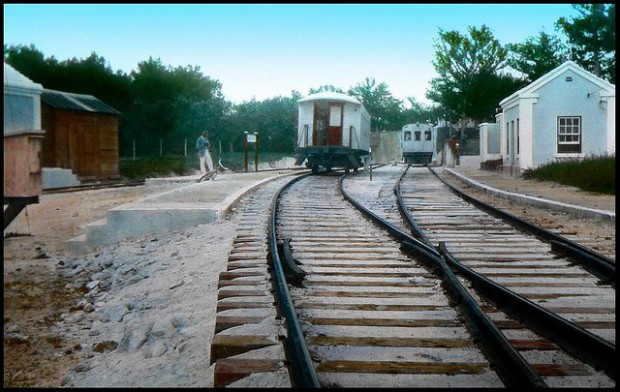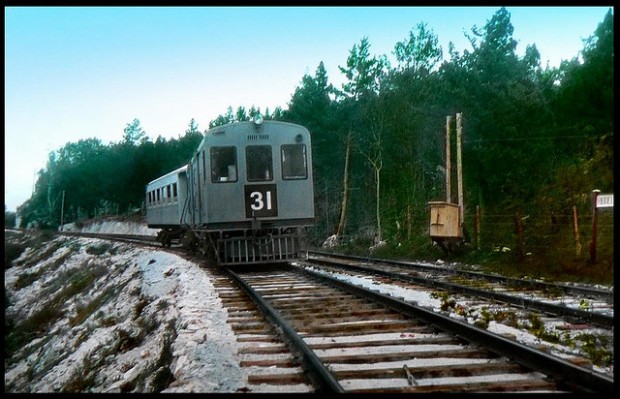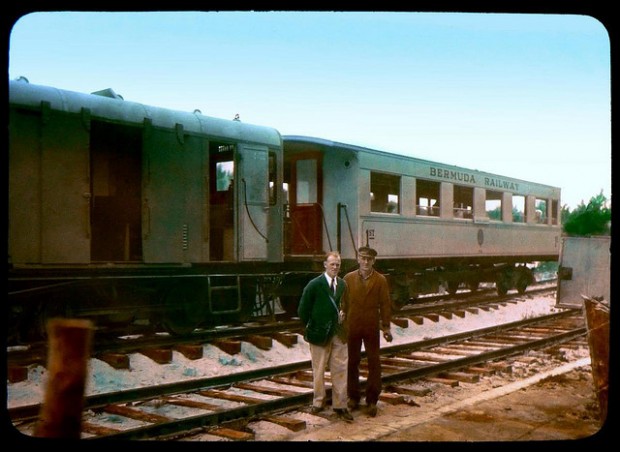Bermuda Railway: ‘Old Rattle and Shake’
 It was one of the shortest railway routes ever built and, mile per mile, probably the most expensive.
It was one of the shortest railway routes ever built and, mile per mile, probably the most expensive.
The Bermuda Railway operated between October 31, 1931 and May 1, 1948. In its 17 years of existence, the 21.7-mile railway line provided frequent passenger and freight service over its length spanning most of Bermuda, from St. George’s in the east to Somerset, in the west.
The railway was the first form of mechanical transportation introduced to the island — Bermuda had prohibited the use of automobiles on its roads in the early 20th century. Bermuda had gone on to actively promote its dependence on horse-drawn and bicycle-powered transport as a quaint lure to attract American and Canadian vacationers. Early tourism advertising boasted Bermuda had ”no motor cars, no railways, no tram cars, no smoke, no soot …”
Construction and maintenance proved to be exceedingly costly, as the Bermuda Railway was built along a coastal route to minimise the amount of land acquisition needed for the right-of-way.
In so doing, however, extensive trestles and bridgework were necessary.
More than ten percent of the line was elevated on 33 separate structures of timber or steel construction spanning the ocean. In addition, the proximity to the ocean made rot and corrosion a significant problem. This, along with the introduction of private automobiles to the island after World War Two would ultimately doom the line.
The Bermuda Railway was a single-track, standard-gauge line with 14 passing sidings. Construction began in 1926, two years after the Bermuda Government granted a 40-year charter to the Bermuda Railway Company, but was not completed until 1931.
“The Bermudas, isles of onions, Easter lilies, lyric grottoes and healing sunshine, has never heard the honking rattle of an automobile or the clank of a chuffing train,” reported “Time” magazine in 1926 when approval to begin construction of the railway was granted. “But Great Bermuda, the largest of the islands is 14 miles long, 1 mile wide. Hack horses and bicycles simply cannot keep up the pace, either of today’s onion industry or of modern fashions in holiday-making.
“Last week, after a 50-year struggle with transportation, the islanders announced that they would have, not automobiles to bury the scenery in pulverised coral from the roads, but a discreet little railroad, linking St. George, Hamilton and Somerset Ferry. The Bermuda Railway Co. Ltd. was careful to add that its trains would have trailers, for baggage and bicycles. Die-hard Bermudians nevertheless shook their heads. ‘Alas’, said they, ‘…Progress’.”
A 1934/35 Bermuda Vacation Home Movie Showing the Bermuda Railway
The initial cost of construction and rolling stock purchase was about $1 million, making it, per mile, the most expensive railway ever built. In inflation-adjusted dollars, the Bermuda Railway cost investors $40 million in today’s terms – or a cost-per-mile of $2 million — a staggering sum for such a short line with limited revenue potential.
Rolling stock consisted of gasoline-powered passenger coaches built in the UK in 1929–1931, a few freight cars, and two diesel locomotives.
Two classes of passenger accommodations were offered: first-class or “Pullman”, with individual wicker chairs, and standard coaches, called “toast racks” because of their walkover seats [that is, the seat backs can be moved across the seat to face either direction of travel].
Regular passenger service began on October 31, 1931, operating from 6 a.m. to midnight at one- to two-hour intervals, depending on the time of day.
Bermuda Railway trains were widely used in the 1930s by commuters, schoolchildren, and shoppers, as private automobiles were not allowed in Bermuda until 1946.
Tourists in particular enjoyed the spectacularly scenic ride alongside the ocean’s edge on the “Old Rattle and Shake” — as the Bermuda Railway came to be known — through the island’s flower-covered hills. Special sightseeing excursions were run for luxury liner passengers.
The Bermuda Railway’s brief history was not without incident. In 1931 vandals attempted to sabotage the railway by placing a large log across the tracks, leading to legislation making it a crime to wreck or attempt to wreck trains.
And in 1936 two passengers were seriously injured and another six cut and bruised when a landslide derailed a Hamilton-bound train.
“The accident occurred in a deep ravine ..,” reported one international news wire service. “Falling stone crushed the top and side of one car and forced the rest of the train off the rails.”
Following heavy usage by US and British armed forces during World War II resulting from the influx of military personnel and the build-up of naval and air force facilities in Bermuda, the railway’s fortunes rapidly declined after war’s end.
“As World War II drew to a close, the Bermuda Railway faced a bleak future,” transportation historian Simon Horn has said in his comprehensive study of the Bermuda Railway. “Since opening in 1931 it had never made money and, as the years passed, was increasingly unable even to break even.
“The war had left the railway in a still worse situation, following six years of greatly increased traffic combined with barely any maintenance. Severe structural problems had been discovered in the line’s many bridges and trestles and, as well, large numbers of sleepers needed replacing.”
In 1945, the Commission on Public Transport presented a report to the Bermuda government. Its figures showed that, between 1932 and 1944, the Railway’s operating profits ranged from a low of £4,430 in 1935 to a high of £42,495 in 1942, the peak traffic year of the War. But this was without even considering depreciation of equipment or buildings. As for the debt load, nothing was ever paid on investor capital; by the end some £400,000 was owing in unpaid interest.
“The company quickly petitioned the Bermuda Government to buy them out, which it did for some £115,000 under the Railway Purchase Act of January 26, 1946,” said Mr. Horn. “The Government appointed the railway’s chief engineer, Harold Kitchen, to head the now publicly owned company.
“The obvious question is, why buy the railway? Did the Bermuda Government feel obliged to maintain the colony’s only public transport, or did it really think there was some way the line could be maintained in public hands?
“A retrospective on the Railway published in … 1985 included an intriguing quote from a Mr. Bob Clarke, who was a member of the Bermuda Public Transportation Board in 1946: ‘We had a meeting with the engineer and an accountant from the English company [the Bermuda Railway's British owners]. They said unless the Bermuda Government bought out the rolling stock and physical assets, they were going to run all the trains down to the yard at East Broadway, lock up the trains and go home. The Bermuda Government was faced with the complete breakdown of public transport and decided to take it over’.”
Mr. Horn said Government sought outside advice, commissioning an American firm of consulting engineer in 1946 to make a study of the Railway and consider possible futures for it.
When the engineers’ report arrived in early April the fate of the Bermuda Railway was sealed.
“Over three-quarters of the Railway’s trestle timbers were showing serious signs of decay,” said Mr. Horn. “To repair or replace the bridges and trestles, along with deteriorating sleepers, rail and other hardware, would cost $306,000. Putting the whole entire railway back into first-class shape would cost $850,000. Conversion of the trackbed into a highway was an even less attractive option, with an estimated cost of $1,819,000.”
Vintage Bermuda Railway Route Map
“No immediate decision was made, and the Railway continued to struggle on through 1946 amid increasing concerns over the safety of the line and the possible need to close certain sections for emergency repairs. In the meantime, the 1946 Motor Car Act was passed, permitting Bermudians to own private motor vehicles. Already by April a bus service was running between Hamilton and Tuckers Town [a part of the island that the Railway had never served].”
The cost of infrastructure rehabilitation, combined with falling passenger levels and ever-increasing deficits, led the Gvernment to conclude that the Bermuda Railway should be abandoned in favour of bus service. After 17 years of operation, the last train ran on May 1, 1948. The rolling stock was later shipped to British Guiana (now Guyana), where they continued to run for several more years in the 1950s.
In 1984, almost 40 years after the last train ran along it, some 18 miles of the defunct rail line’s right-of-way were dedicated as the Bermuda Railway Trail for hiking and, on some paved portions, biking.
Frommer’s travel guide calls one of its “Favorite Bermuda Experiences”, extolling its “panoramic seascapes, exotic flora and fauna, and soothing sounds of the island’s bird life.”






Thank you this was a fantastic article and well worth a read. Thank you.
Fantastic Bernews. Keep these kind of articles rolling!!
The Bda Archives has a film done by my great grandfather when he came to Bermuda in 1929. Feel free to use that one since it uses the train too!!
I love reading stories and seeing pictures of the Old Bermuda. Please, if you have more stories like this please post them.
Fantastic job, Pat, per usual. My father, along with many others, came out from England to work on the Bermuda Railway, so these films and text provided a glimpse into a time when Bermuda was truly serene and lovely. I remember him saying they used to hold the train up for Sheila Gosling, then a schoolgirl, as she rushed along with her bicycle to catch it. Thank you.
love this article Bernews! I look forward to future stories on old Bermuda as we get closer to Heritage month
OUTSTANDING PAT. KEEP UP THE GREAT WORK. IT IS A TREASURE TO BE ABLE TO RECONNECT TO THE BERMUDA OF THE GOOD OLD DAYS. BLESSINGS.
Bermuda History lesson…Thank you Bernews for this article…Loved it!!! I kind of wish the rail line was still in existence (upgraded), as this would be a major mode of transportation used to combat our traffic problems!!!